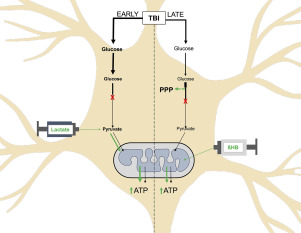当前位置:
X-MOL 学术
›
Exp. Neurol.
›
论文详情
Our official English website, www.x-mol.net, welcomes your
feedback! (Note: you will need to create a separate account there.)
Alternative substrate metabolism depends on cerebral metabolic state following traumatic brain injury.
Experimental Neurology ( IF 4.6 ) Pub Date : 2020-04-02 , DOI: 10.1016/j.expneurol.2020.113289 Tiffany Greco 1 , Paul M Vespa 2 , Mayumi L Prins 3
Experimental Neurology ( IF 4.6 ) Pub Date : 2020-04-02 , DOI: 10.1016/j.expneurol.2020.113289 Tiffany Greco 1 , Paul M Vespa 2 , Mayumi L Prins 3
Affiliation

|
Decreases in energy metabolism following traumatic brain injury (TBI) are attributed to impairment of glycolytic flux and oxidative phosphorylation. Glucose utilization post-TBI is decreased while administration of alternative substrates has been shown to be neuroprotective. Changes in energy metabolism following TBI happens in two phases; a period of hyper-metabolism followed by prolonged hypo-metabolism. It is not understood how different cerebral metabolic states may impact substrate metabolism and ultimately mitochondrial function. Adult male or female Sprague Dawley rats were given sham surgery or controlled cortical impact (CCI) and were assigned one of two administration schemes. Glucose, lactate or beta-hydroxybutyrate (BHB) were infused i.v. either starting immediately after injury or beginning 6 h post-injury for 3 h to reflect the hyper- and hypo-metabolic stages. Animals were euthanized 24 h post-injury. The peri-contusional cortex was collected and assayed for mitochondrial respiration peroxide production, and citrate synthase activity. Tissue acetyl-CoA, ATP, glycogen and HMGB1 were also quantified. Sex differences were observed in injury pattern. Administration based on cerebral metabolic state identified that only early lactate and late BHB improved mitochondrial function and peroxide production and TCA cycle intermediates in males. In contrast, both early and late BHB had deleterious effects on all aspects of metabolic measurements in females. These data stress there is no one optimal alternative substrate, but rather the fuel type used should be guided by both cerebral metabolic state and sex.
中文翻译:

替代底物代谢取决于创伤性脑损伤后的脑代谢状态。
创伤性脑损伤 (TBI) 后能量代谢的减少归因于糖酵解通量和氧化磷酸化的损害。TBI 后的葡萄糖利用率降低,而替代底物的给药已被证明具有神经保护作用。TBI 后能量代谢的变化发生在两个阶段;一段高代谢期,然后是长时间的低代谢期。目前尚不清楚不同的大脑代谢状态如何影响底物代谢并最终影响线粒体功能。对成年雄性或雌性 Sprague Dawley 大鼠进行了假手术或受控皮质撞击 (CCI),并分配了两种给药方案中的一种。静脉输注葡萄糖、乳酸或 β-羟基丁酸 (BHB) 要么在受伤后立即开始,要么在受伤后 6 小时开始持续 3 小时,以反映高代谢和低代谢阶段。动物在受伤后 24 小时被安乐死。收集挫伤周围皮层并分析线粒体呼吸过氧化物的产生和柠檬酸合酶活性。组织乙酰辅酶A、ATP、糖原和HMGB1也被量化。在损伤模式中观察到性别差异。基于脑代谢状态的给药确定只有早期乳酸和晚期 BHB 改善了男性的线粒体功能和过氧化物产生和 TCA 循环中间体。相比之下,早期和晚期 BHB 对女性代谢测量的各个方面都有有害影响。这些数据强调没有一种最佳的替代基材,
更新日期:2020-04-03
中文翻译:

替代底物代谢取决于创伤性脑损伤后的脑代谢状态。
创伤性脑损伤 (TBI) 后能量代谢的减少归因于糖酵解通量和氧化磷酸化的损害。TBI 后的葡萄糖利用率降低,而替代底物的给药已被证明具有神经保护作用。TBI 后能量代谢的变化发生在两个阶段;一段高代谢期,然后是长时间的低代谢期。目前尚不清楚不同的大脑代谢状态如何影响底物代谢并最终影响线粒体功能。对成年雄性或雌性 Sprague Dawley 大鼠进行了假手术或受控皮质撞击 (CCI),并分配了两种给药方案中的一种。静脉输注葡萄糖、乳酸或 β-羟基丁酸 (BHB) 要么在受伤后立即开始,要么在受伤后 6 小时开始持续 3 小时,以反映高代谢和低代谢阶段。动物在受伤后 24 小时被安乐死。收集挫伤周围皮层并分析线粒体呼吸过氧化物的产生和柠檬酸合酶活性。组织乙酰辅酶A、ATP、糖原和HMGB1也被量化。在损伤模式中观察到性别差异。基于脑代谢状态的给药确定只有早期乳酸和晚期 BHB 改善了男性的线粒体功能和过氧化物产生和 TCA 循环中间体。相比之下,早期和晚期 BHB 对女性代谢测量的各个方面都有有害影响。这些数据强调没有一种最佳的替代基材,











































 京公网安备 11010802027423号
京公网安备 11010802027423号